





During a race, a horse's legs have to support more than 1,000 pounds of bodyweight traveling at speeds up to 40 miles an hour, so it is no surprise that joint injuries are common among racehorses.
Humans and horses are alike in that joint cartilage is highly susceptible to injuries. Joint cartilage suffering from excessive wear and tear likely causes arthritis, which is a common symptom after excessive exercise.
Horses suspected of suffering from arthritis are sent to the Veterinary Department and diagnosed by clinical examination and X-ray check. Veterinary surgeons will provide appropriate treatment to horses according to the progress of their condition, usually reducing the amount of exercise and prescribing joint medication.
In addition to arthritis, the edges of joint bones are at risk of chipping when horses race, especially the front of knee joints and the front of fetlock joints. When chipping problems occur in knee or fetlock, the chips have to be taken out by arthroscopy surgery. The injured horses rest for a period and joint medication must be applied.
Even when horses recover after arthroscopy surgery, there is no guarantee they will completely convalesce and be able to race as well as they previously did. There are different cases with different factors. The later performances of some horses may not be affected at all.
Racing fans have to make their own decisions by observing how the horse works after resuming from a long break. In particular, they need to make an objective assessment of it after they have watched its first few races back. Decisions need to be based on hard facts, and it may need to be down-rated - even if it has been your favorite horse!
Some horses that have been racing well and are still middle-aged suddenly lose all form and race dreadfully. Some of them never regain their good form and are beaten thereafter. When this happens, it is usually because of hidden health problems.
There also are horses that are well bred and look good but who never seem to race up to their potential. Hidden problems may also be to blame in some of these cases while quite often the other reason is that the horses have not adjusted themselves to the environment they face after arrival Hong Kong.
How well horse races basically depend on three factors: its quality, its fitness and preparation, and its health.
If horses develop internal health problems or are injured, they usually are in pain. Often the intensity of the pain increases with the severity of exercise. Pain reduces the horse's desire to race, and some ailments restrict its physical movement.
Common causes of pain that reduce performance of horses are:
joint disease tendon and ligament injuries bone injuries foot problems back and pelvic conditions stomach ulcers.
Understanding how injuries, ailments and other circumstances can affect horse performances is an important part of race analysis. Such understanding can help you avoid losing bets on horses that are not ready or able to win.
The most obvious track bias occurring in Hong Kong racing is at Happy Valley Racecourse, followed by the all-weather track at Sha Tin while the Sha Tin turf track is the less biased.
Happy Valley Racecourse is a small track with tight turns, which means that it is best suited to front runners or "on the pace" horses for the majority of times. The location of the rail in the C and C+3 positions make this more pronounced due to the track design. The location of the starting points also affects the bias and this is even more evident with the 1000m and 1200m starting positions, favouring horses drawn close to the inside rail.
The rail configuration at Happy Valley was changed commencing February 2000 to incorporate the worked back design. Happy Valley is a typical old style city venue track and as such the size of the venue has not allowed the incorporation of transitional bends before the main bend. This again helps favour front runners or on pace horses.
Most dirt or sand based all-weather tracks favour front runners, which is more obvious if the race tempo is moderate. When the track is sealed during the wet weather, it will become very favourable for front runners.
Based on the statistical data, Sha Tin turf track exhibits a small amount of bias, except the following cases:
Track bias does occur and can even change during a meeting as the ground changes. While there are general indicators as discussed, there are not always hard and fast rules and these predictions may be inaccurate. However, understanding track design and track bias is a very important part of race-form analysis.
"Track bias" is a term used to describe how one part of a racetrack may be different from another part.
It could cover many different conditions in such matters as hardness of the surface, angles of the surface from a true flat position, the configuration of turns, the type of surface, where the starting gate is located and so forth.
Track bias is a feature of racing around the world and is not unique to Hong Kong racing. It has, however, become a widely discussed topic in racing circles over the last ten to 15 years.
There are three major factors that cause track bias:
There are many design factors that may create a pattern of racing which can advantage or disadvantage horses. Some of these examples are:
The usage pattern on a track will influence the performance of the track. Racing in many countries has increased considerably over the last 30 years and to help overcome some of the issues associated with the increase, the concept of the movable rail was introduced. Examples of usage affecting track bias:
Weather condition will influence track performance. A very dry track can favour on-pace horses. A wet track will often favour off-pace horses. When a grass track dries out quickly after rain, it will often favour leaders or on-pace runners.
The competitive power of a horse basically depends on two factors, its physiology and its condition.
Physiology consists of two broad phases. The first is characterised by growth and maturity, and the second by degeneration and ageing. In phase 1, juvenile horses sometimes mix their form dramatically, but as a horse matures, its competitive power tends to rise to a level where its performances are relatively consistent. In phase 2, general competitive power gradually diminishes with age, and the horse's performances tend to become less consistent. During this phase, horses find it more difficult to hold their form for many runs.
Condition - a horse's fitness, health and general well being - varies in relation to its different physiological stages. When a progressive juvenile is in top condition, it can improve sharply on what it has done before, and as it grows, and if its condition remains good, it can improve from race to race. A horse that is fully mature and in top condition will race consistently and perform at the best level it is capable of. When a horse is ageing and physically degenerating, its will become prone to disappointing and inconsistent performances.
Form generally runs in cycles that differ from horse to horse, usually in correlation with their constitution, or physical and mental make-up. Some horses can hold form for a long time, while others can hold it for only one or two runs. The first group give relatively more consistent performances while the second group can appear inconsistent. However, good trainers can space the runs of horses in the second group so that they race only at the top of their form cycle.
Many factors can affect a horse's condition, including its physiological state, or changes in climate, environment, training or feeding methods. When both internal and external factors are favourable, it tends to perform consistently, and vice versa. However, consistency also hinges on psychological factors such as determination, courage, competitive spirit, loyalty and temperament.
From a punter's standpoint, consistent racehorses are more reliable to bet on. We can make judgements on the consistency of an individual horse by considering the above perspectives - the more positive points we can sum up for a particular runner, the more reliable it is likely to be. However, we should not forget the proverb that says: "things always reverse themselves after reaching an extreme". Forecasting when horses that have been racing well are likely to drop in form is difficult, but we should be wary of those that have performed at their highest level in recent starts.
Racing commentators, jockeys and trainers, as well as Racing Incident Reports and Comments-In-Running issued by the Jockey Club often mention the term "cover" in sentences such as "the horse had to find cover" or "the horse was obliged to race wide throughout without cover and gave ground over the concluding stages".
Very often, a horse's sub-standard race performance is attributed to its inability to obtain cover in a race. In fact, quite a number of horses perform very well when they have cover, but never without. What, then, is "cover"? Why does it act as a key factor for the performance of the same runner?
"Cover" means that a horse follows the others in the race and uses them as a form of shelter before its jockey asks it to quicken up in the closing stages of a race. Horses "without cover" are those that are widest on the track with no horse in front of them.
Some horses are front-runners. They love being allowed to race in the lead where they produce their best form. Other horses, however, are not suited to being in front and are better off being restrained behind the one in front. Now if a horse races too fast in the early or middle stages of race and uses up too much energy to soon, it will have nothing left to finish off the race with. The horse runs out of gas.
Horses tend to over-race if they do not have cover and are harder for their riders to settle. As a result, they may try and run too freely and "pull" against its rider's hold. Therefore, if a jockey is riding a horse that is not a front-runner, the jockey will usually try and get some cover for his mount, where it is less exposed to the breeze, and where it travels in the slipstream of the horse in front. Here it can travel comfortably and finish the race off strongly when asked.
Most horses can perform best only if they can find cover in the run, especially those who race keenly or have little racing experience. The barrier draw is naturally an important factor in deciding whether a horse is likely to find cover or not. The higher the number, the further away from the inside, and the harder it is to obtain cover.
Nevertheless, there are, as ever, exceptions to the rule. Some horses prefer to have room in the run and don't like being covered-up. Olympic Express, the Hong Kong Mile and Hong Kong Gold Cup winner, is a good example.
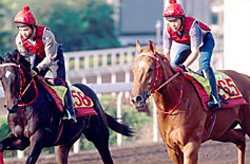
"Gallop in pairs" is a commonly used term in local racing newspapers, which means that a set of two or sometimes three horses gallop together in morning workouts. If two or more horses trot in company, it is so-called "trot in pairs".
Basically, there are two patterns of gallop in pair, one of which is that two horses start in sequence, with the one lagging behind speeding up en route, mostly in the last quarter, to keep abreast of the leader. The second one is that two horses start at the same time, or run together bridle to bridle, or one horse trails another, until the duo makes a run in the last quarter.
As one of the many ways to train horses, gallop in pair mainly performs the following functions. It can lift a horse's fighting spirits. Horses are both herd animals and inborn racing specialists. When they run and wheel about in a mob, they will become particularly enthusiastic as the faster animal can display a sense of superiority over its peers. In the wild, the superior horse enjoys greater and is often a leader. Though thoroughbreds differ profoundly from wild horses as to their lifestyle, they are still used to competing amongst each other to distinguish the strong from the weak. If a horse has not raced with other horses for a long time, its fighting spirits may diminish.
Trainers may examine the progress of a horse through galloping in pairs. As each horse has its own characteristics, some are smart enough to be lazy in their morning work. They are likely to appear languid and dispirited when they work independently on the training track, making it difficult to assess whether they are improving or declining in form and how much better or worse they are. Nevertheless, they may display much enthusiasm right away and show their true colours when they gallop in company at trackwork.
Trainers may also make use of galloping in pairs to educate horses. Young and green horses with little racing experience may need more training and through couples of gallops in pair they can learn how to stretch out properly, conserve energy and switch on at the right time. Some horses that have been unruly in races (if they have been laying in or out) can be arranged to work on the inside or outside when galloping in pair, during which the guidance of companions can help correct these problems.
Working in pairs is a way to boost a horse's form. However, equine stamina will steadily decline with an increase in workouts. Excessive gallops will inevitably produce undesirable effects. It is up to trainers who, based on their professional expertise and experience, arrange which horses should be given such kind of work and when it should be done.
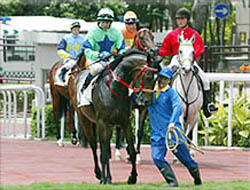
Sweating is a normal physiological phenomenon when horses exercise aiding blood circulation and that leads to increased body temperature. Perspiration is therefore a cooling process that helps lower the body temperature. However, if a horse sweats profusely or is unable to sweat, it may suggest that the horse is not in good health, or suffering from a disease.
In a racing commentators' opinion, horses that types of sweating which occur on the training track or prior to races can be roughly classified into four conditions: normal perspiration; heavy sweating owing to excess condition; abnormal perspiration due to weakness of constitution; nervous sweating. "Normal perspiration" aside, it is not encouraging to see the other types of sweating mentioned. Excessive perspiration can cause fatigue such that horses fail to perform satisfactorily in races. Exceptions occur of course as each horse has its own characteristics.
Normally, horses sweat if they are not fit, especially when resuming training after a summer break. Since horses experience much less exercised during the break, fat is stored in their bodies and they may become a little flabby. In early season, it is common to see that some horses perspire all over in morning workouts, particularly on the neck, chest and shoulders. Heavy sweating often works itself into a white lather across these areas and flow down the horse's legs.
If a horse is not sweating up after it resumes work after its summer break, it may be down to the following possibilities: the horse may have been doing some exercise in its stable during the break preventing excessive condition. It may also have a poor appetite or suffer from ailments in digestive system, resulting in poor nutritional absorption, therefore failing to put on weight.
The sweating of horses is related to seasonal and weather changes. They perspire when it is hot sweat less when it cools. The amount of sweat that oozes out during morning workouts correlates with the amount of works horses have done beforehand. Some horses sweat all over as they walk to the track because they may have done just trotting beforehand or been on the "horse walker" machine.
It takes a bit of knowing, but it is possible to assess the condition of a racehorse by the amount it sweats at any given time. Only by repeated observation can we make an accurate evaluation.
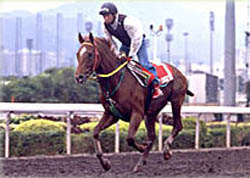
One of the noticeable points when watching a horse working on the training track is the gait, that is, whether it runs with light or heavy steps. It serves as one of the important indicators of a horse's current form.
Horse racing, by nature, is the performance and competition of strength. Whether a horse gallops with light or lagging feet is directly related to its reserves of energy. If a horse is in cracking form, it appears to be alive in every fibre, running with springy steps that just glide over the ground. Once out of form, it is weak and leaden-legged, finding it difficult to stride out well. In other words, the lighter the steps, the better the form it will be; whereas it is likely to be farther away from tip-top shape if it canters with heavier steps.
A horse's gait and its condition are related. If the horse is overweight, this increases the burden on the legs and they will inevitably move with heavy feet. If horses look fit, the burden on the legs is lessened and they can gallop briskly. But horses cannot be too thin. Otherwise, they may conserve no strength due to being underweight.
One may differentiate whether a horse has light or heavy feet when running with naked eyes, and it should come as no surprise, by using one's ears. In Hong Kong racing history, some horses used worked in midnight during amateur times even the track lights were switched off. While track watchers could not see clearly, they still relied on listening to hoofbeats to help them make correct judgment. Nevertheless, such methods of listening the passing of hooves can still be used to good effect nowadays. It is encouraging to listen to a horse running with light steps. If the hoofbeat sounds like the roll of drums, one may have ample grounds to be sceptical about the horse's current form and condition.
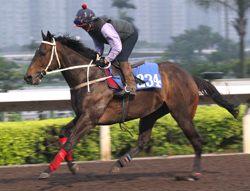
Some horses work frequently, which is so-called "hard track workers" in local racing newspapers, meaning among which some may even show up at trackwork almost every morning. In contrast, some horses work once at rather long intervals (so-called "infrequent track workers"). Why does such variation occur? And how does the frequency of these workouts influence a horse's performance in a race?
In local racing, two strong, fast workouts on the training track a week are deemed as the most common form of maintaining fitness in the horse. Horses usually do fast work every Monday and Thursday; every Tuesday and Friday; or every Wednesday and Saturday - in between three-day intervals. Workout schedules are usually arranged in such patterns.
Trainers regulate the workout frequency of each horse according to the horse's needs and they will shorten a horse's fast work cycle if they wish to increase its work volume. For instance, the horse may be worked fast every second day so that it does strong works three times a week. If horses are required to ease up training, trainers will lengthen their fast work cycle and give them only one strong work or even none except for such light works as canters or trots ("slow work"). If horses race rather frequently within a certain period of time, the frequency of fast works may be correspondingly lessened in order to avoid fatigue.
Racing fans should understand that the frequency of work may not be directly proportional to performances in races. In other words, heavy workouts do not guarantee a creditable performance while light workouts similarly do not mean that such horses will perform poorly in races. The question is whether the volume and pattern of training is well suited to the horse's constitution, characteristics, health condition and current form. Excessive training may instead make a horse run below par. Horses undergoing insufficient training are likely hovering around recent form. Nevertheless, it is clear that horses that can endure frequent fast workouts are generally healthy.
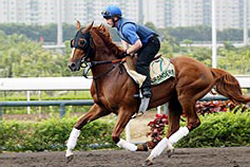
Some horses work on the bit on the training track and with such great vigour that their riders need to pull hard against them. Nevertheless, they are either well beaten after leading for some distance or dispirited when following the field throughout on the racetrack. It seems that they are completely different horses when compared with their "invincibly sharp" impression given at trackwork.
The so-called "burning up the track in workouts" actually gives a false impression that horses are in good form, which usually happens to horses that incline to pull hard in racing and griffins that still do not know how to conserve their energy reserve for the finish. In morning workouts, horses generally gallop for a distance shorter than on race day in order to preserve their stamina. Those that are not at optimum fitness can still gallop for 400 metres or even 800 metres without fatigue.
Once in the race, they will exceed their ability to run faster for longer showing their true colours.
In most cases, it is not encouraging to see horses pull hard or run freely in morning walkouts.
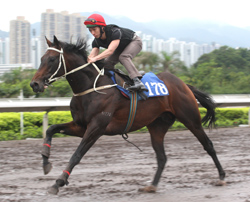
A glance at trackwork times reveals that different horses do their morning exercise in different ways and at different speeds. A horse's race preparation is done according to the individual needs of the horse and it is not enough to take one look at its workout time to judge whether or not it is at peak fitness and ready to perform well on the track.
Morning work patterns can be split into three categories - gallops, canters and trots - and these different speeds or 'gaits' naturally produce different effects in terms of the fitness of a horse. If horses are athletes, trainers are coaches that take into account each horse's individual characteristics, constitution, physique, current form and consistency when arranging its work schedule and selecting the most suitable pattern for it.
When a horse clocks a fast time in the morning it could mean that its trainer is sharpening it up, suggesting that the horse is improving but not yet at the peak of its condition. Once it is at optimum fitness, hard training is no longer needed - the horse needs only be kept 'ticking over'.
However, a horse clocking a good time in a workout may also reflect that it is in good form, sharp and vigorous.
So how do we differentiate the former 'fast' workout from the latter?
Use your eyes. Compare the workout time with the way the horse did the work. Did it look like the horse was all out and under pressure from its rider to achieve that time? If that was the case, you may want to revise your opinion on the horse's current form.
The best way of corroborating good exercise with a good workout time is to spot the horse that works fast and comfortably under a tight rein or the one immediately responds with quicker, longer strides once his rider niggles him to pick up the bit and stretch.
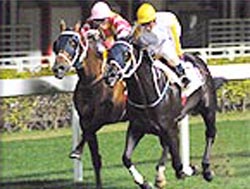
Horses are herd animals, and in their natural environment seem to be able to run and wheel about in a mob without striking each other's heels. However, in a horse race, when a human is in charge of the steering mechanism, a horse's natural ability to avoid heels appears to be affected by the introduction of this human interference with nature.
In fair racing each horse must be entitled to gallop without restriction in the ground in which it has established itself.
But some riders are inclined to disregard caution when endeavouring to move in closer to the rails in order to save ground on turns, or to move in or out to take advantageous positions at critical stages of a race. It causes danger to the lives of horse and rider when the rider of one horse takes it across the running of another. There is the likelihood of the outstretched front legs of the rear horse clipping the extended hind legs of the horse in front. Even the possibility of the front legs of a horse being contacted is a recipe for disaster and loss of life or serious injury. The potential sudden fall of a horse in these circumstances makes reckless, close crossing one of the most dangerous actions in horse racing.
Therefore, since racing first started there has been a constant debate on what is a safe and practical clearance in these circumstances. The standard adopted by the Racing Stewards in Hong Kong is at least two lengths clear that is, the length of the horse crossed plus a length.
The clearance space required in front of the horse being crossed is the distance to be taken up by its outstretched front legs, plus the distance taken up by the extended back legs of the horse crossing, plus a safety clearance margin of at least a foot. For practical purposes, this distance is about the length of a horse standing still. The crossing rider also has to ensure that his shift takes into account the possibility of his mount's front legs contacting the heels of the horse racing ahead of the space he is intending to fill.
The clearance space required in front of the horse being crossed is the distance to be taken up by its outstretched front legs, plus the distance taken up by the extended back legs of the horse crossing, plus a safety clearance margin of at least a foot. For practical purposes, this distance is about the length of a horse standing still. The crossing rider also has to ensure that his shift takes into account the possibility of his mount's front legs contacting the heels of the horse racing ahead of the space he is intending to fill.
A length in racing is recognized as the length of a horse standing still, and that "two-lengths-clear" is taken by racing people and the public to mean "a horse's own length plus another length clear of the horse whose running is being crossed".
The requirement could be expressed as "one clear length ahead of a horse before the commencement of any move across its running".
A horse needs at least one clear length to accommodate its front legs and the outstretched heels of the horse in front. In many places around the world this is not considered satisfactory, however, with the competitive style of racing in Hong Kong this is a minimal distance for safety.
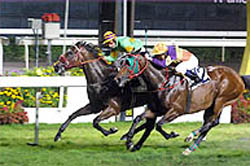
There are many factors affecting the pace of a race. Among them, the most important one is the racing style of the runners. Horses have their unique racing style and can be divided into three main categories: front-runners, back-finishers and one-paced runners. If most of the runners in a race are front-runners, the pace of the race would generally be faster. Conversely, if most of them are back-finishers, the pace would generally be slower. The early pace of a race can be affected by change of riding instructions, no clear fast leader in the race, or incidents that could happen soon after the start.
The 1st and the 2nd Sections of the Island Handicap ran at Happy Valley on 26 September 2001 were both 1650-metre Class 3 races for horses rated between 70 to 50. As there were only a few front-runners in the 1st Section, the pace of the race was slow. The time for the first 1250 metres was 1.19.5 minutes and that for the whole race was 1.42.9. As there were more front-runners in the 2nd Section, the pace of the race was much faster. The time for the first 1250 metres was 1.16.8 minutes and that for the whole race was 1.40.4. Since the pace of the 1st Section was slow, the final stages could be finished in just 23.4 seconds with Aspiration running on forwards the finish and won. In the 2nd Section, Pristine made all, setting his own pace throughout. It finished the last 400 metres in only 23.6 seconds and won by 4 1/2 lengths, showing that its performance was much better than that of the other runners.
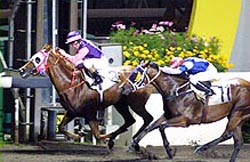
Please take a look at the following formulae:
In these formulae, the sum is 6 no matter how the sequence of the three numbers is arranged. However, the case is not so simple in the racing world. Riders must use tactics that suit the characteristics of their mounts in order to be effective. If a front-runner can finish a 1200-metre race in 1.10 minutes, it may not be able to finish it within the same time if it is held up for a late finish. Similarly, if a back-finisher can finish a 1600-metre race in 1.35 minutes, it can hardly finish within the same time if it tears away early on.
However, there are no hard-and-fast rules. The tactics that are employed in a race can vary, depending on circumstances. Jockeys should exercise their initiative and make the necessary adjustments to suit different circumstances.
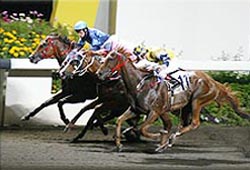
Front-runners that can maintain their leading positions in slow pace throughout the race are able to save their energy for a late burst. However, runners that lag behind early have to run even faster than those in front if they want to catch up from the back. It is difficult for late finishers to catch the front-runners if the latter can maintain a high speed in the final stages. For instance, front-runners that finish the final 400 metres in 23.5 seconds can only be caught if late finishers, which are behind by five lengths in the last 400 metres, can finish in 22.5 seconds or less. If the late finishers cannot reach that speed, usually they cannot win.
The Kagoshima Handicap, a 1800-metre Class 2 race, held at Sha Tin on 13 October 2001 best illustrates that front-runners are suitable for slow run races. In this race, Turbojet led and covered the first 1400 metres in as slow as 1.26.3 minutes. However, he finished the final 400 metres in just 22.7 seconds. Luckswell, another usual front-runner, had also taken advantage of the slow pace of the race and took the second place. Very few horses can finish the last 400 metres of a 1800-metre race in less than 22.5 seconds. Therefore Equikit, which caught up from the back, performed brilliantly in that race and took third place, losing by just a head.
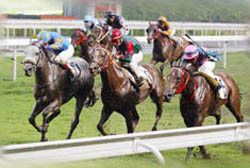
There is an old Chinese saying: "Running fast can put one at an advantageous position." But this is not so in the racing world. There are limitations to the speed and stamina of racehorses. Thoroughbreds can maintain their highest speed for no more than 400 metres. Those that run too fast in the early stages of a race will burn themselves out. Conversely, those that run slow early on have enough energy to quicken up in the latter part of the race.
The 1600-metre Sha Tin Trophy (G3) held on 21 October 2001 was a good example of how late finishers are suited to fast run races. The time taken to finish the first 1200 metres was 1.10.2 minutes which was 2.3 seconds faster than that of the 1600-metre Yan Chai Trophy (Class 2) just 30 minutes earlier. However, the time taken to finish the last 400 metres of the Sha Tin Trophy was 24 seconds whereas that of the Yan Chai Trophy was only 22.7 seconds. As the pace of the Sha Tin Trophy was fast early on, those racing prominently such as Man Of Honor, Citizen Kane, Red Pepper and Oriental Express became exhausted after entering the straight, and it was the horses that settled off the early speed that had the greater finishing kick and filled the first three places.
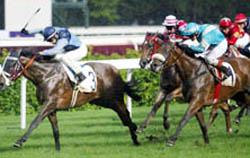
Local racing fans usually call non-handicaps as 'terms' races. However, most of the so-called 'terms' races are in fact weight-for-age races. The Prix de l'Arc de Triomphe held in France on 7 October 2001 is a good example. Among the runners, one of them was a five-year-old carrying 131 lb. Eight were four-year-olds with six carrying 131 lb and the other two carrying 128 lb. Another eight were three-year-olds with six carrying 123 lb and the other two carrying 120 lb.
The variation in the weight is as a result of the application of the weight-for-age allowance. In this race, four-year-olds and up must carry 131 lb while three-year-olds carry 123 lb, enjoying a weight pull of 8 lb. Besides, fillies and mares carry 3 lb [there is an allowance for fillies and mares in all French races of 1.5 kg (3.25 lb)] less than colts of the same age. That is why runners of the same age carry different weight in the same race.
Another example is the Bauhinia Sprint Trophy race 2001. All four-year-olds and up in that race carried 126 lb except Crystal Charm which is a mare and received 3 lb and King Of Danes which is a three-year-old and received 5 lb, thus carrying 121 lb.
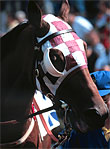
Blinkers are used for three main purposes:
For instance, some horses may be curious and wanting to look around. Some may be nervous and will become scared or restless even if only something subtle is happening. Some horses may not run properly and keep shifting in and out, or tend to lean against horses by their side. Others may need to increase early speed when running short distance. Trainers require horses to wear blinkers whenever they think it's necessary. Besides, they may also require horses that have never achieved good results and always lose in races to wear blinkers so as to give them stimulation and arouse their interest in racing.